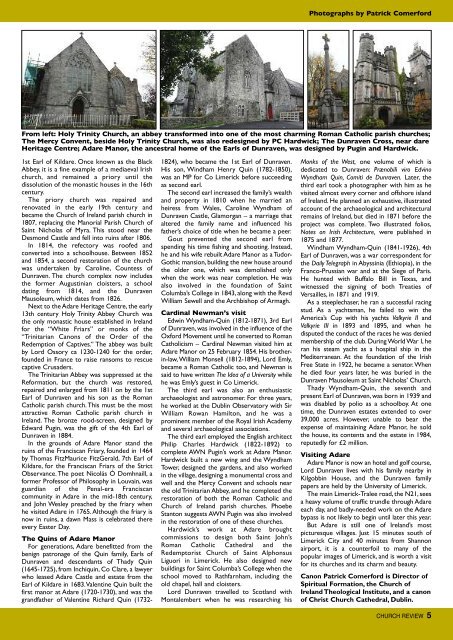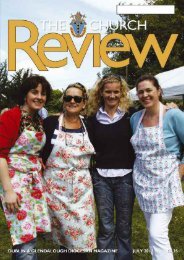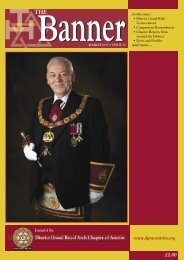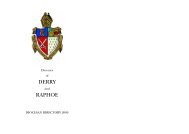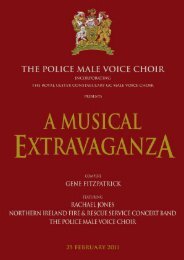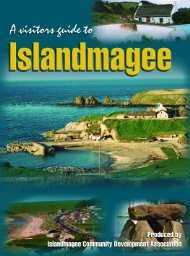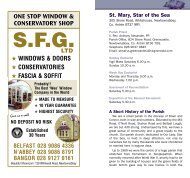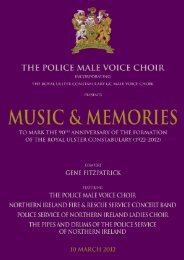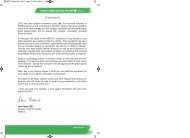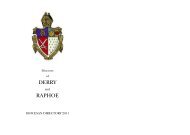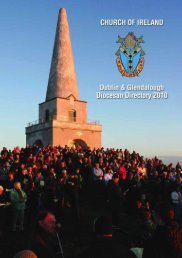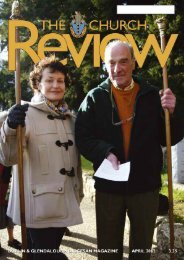You also want an ePaper? Increase the reach of your titles
YUMPU automatically turns print PDFs into web optimized ePapers that Google loves.
Photographs by Patrick Comerfordfrom left: holy trinity Church, an abbey transformed into one of the most charming roman Catholic parish <strong>church</strong>es;the Mercy Convent, beside holy trinity Church, was also redesigned by PC hardwick; the dunraven Cross, near dareheritage Centre; adare Manor, the ancestral home of the earls of dunraven, was designed by Pugin and hardwick.1st Earl of Kildare. Once known as the BlackAbbey, it is a fine example of a mediaeval Irish<strong>church</strong>, and remained a priory until thedissolution of the monastic houses in the 16thcentury.The priory <strong>church</strong> was repaired andrenovated in the early 19th century andbecame the Church of Ireland parish <strong>church</strong> in1807, replacing the Manorial Parish Church ofSaint Nicholas of Myra. This stood near theDesmond Castle and fell into ruins after 1806.In 1814, the refectory was roofed andconverted into a schoolhouse. Between 1852and 1854, a second restoration of the <strong>church</strong>was undertaken by Caroline, Countess ofDunraven. The <strong>church</strong> complex now includesthe former Augustinian cloisters, a schooldating from 1814, and the DunravenMausoleum, which dates from 1826.Next to the Adare Heritage Centre, the early13th century Holy Trinity Abbey Church wasthe only monastic house established in Irelandfor the “White Friars” or monks of the“Trinitarian Canons of the Order of theRedemption of Captives.” The abbey was builtby Lord Ossory ca 1230-1240 for the order,founded in France to raise ransoms to rescuecaptive Crusaders.The Trinitarian Abbey was suppressed at theReformation, but the <strong>church</strong> was restored,repaired and enlarged from 1811 on by the 1stEarl of Dunraven and his son as the RomanCatholic parish <strong>church</strong>. This must be the mostattractive Roman Catholic parish <strong>church</strong> inIreland. The bronze rood-screen, designed byEdward Pugin, was the gift of the 4th Earl ofDunraven in 1884.In the grounds of Adare Manor stand theruins of the Franciscan Friary, founded in 1464by Thomas FitzMaurice FitzGerald, 7th Earl ofKildare, for the Franciscan Friars of the StrictObservance. The poet Nicolás Ó Domhnaill, aformer Professor of Philosophy in Louvain, wasguardian of the Penal-era Franciscancommunity in Adare in the mid-18th century,and John Wesley preached by the friary whenhe visited Adare in 1765. Although the friary isnow in ruins, a dawn Mass is celebrated thereevery Easter Day.the Quins of adare ManorFor generations, Adare benefitted from thebenign patronage of the Quin family, Earls ofDunraven and descendants of Thady Quin(1645-1725), from Inchiquin, Co Clare, a lawyerwho leased Adare Castle and estate from theEarl of Kildare in 1683. Valentine Quin built thefirst manor at Adare (1720-1730), and was thegrandfather of Valentine Richard Quin (1732-1824), who became the 1st Earl of Dunraven.His son, Windham Henry Quin (1782-1850),was an MP for Co Limerick before succeedingas second earl.The second earl increased the family’s wealthand property in 1810 when he married anheiress from Wales, Caroline Wyndham ofDunraven Castle, Glamorgan – a marriage thataltered the family name and influenced hisfather’s choice of title when he became a peer.Gout prevented the second earl fromspending his time fishing and shooting. Instead,he and his wife rebuilt Adare Manor as a Tudor-Gothic mansion, building the new house aroundthe older one, which was demolished onlywhen the work was near completion. He wasalso involved in the foundation of SaintColumba’s College in 1843, along with the RevdWilliam Sewell and the Archbishop of Armagh.Cardinal newman’s visitEdwin Wyndham-Quin (1812-1871), 3rd Earlof Dunraven, was involved in the influence of theOxford Movement until he converted to RomanCatholicism – Cardinal Newman visited him atAdare Manor on 25 February 1854. His brotherin-law,William Monsell (1812-1894), Lord Emly,became a Roman Catholic too, and Newman issaid to have written The Idea of a University whilehe was Emly’s guest in Co Limerick.The third earl was also an enthusiasticarchaeologist and astronomer. For three years,he worked at the Dublin Observatory with SirWilliam Rowan Hamilton, and he was aprominent member of the Royal Irish Academyand several archaeological associations.The third earl employed the English architectPhilip Charles Hardwick (1822-1892) tocomplete AWN Pugin’s work at Adare Manor.Hardwick built a new wing and the WyndhamTower, designed the gardens, and also workedin the village, designing a monumental cross andwell and the Mercy Convent and schools nearthe old Trinitarian Abbey, and he completed therestoration of both the Roman Catholic andChurch of Ireland parish <strong>church</strong>es. PhoebeStanton suggests AWN Pugin was also involvedin the restoration of one of these <strong>church</strong>es.Hardwick’s work at Adare broughtcommissions to design both Saint John’sRoman Catholic Cathedral and theRedemptorist Church of Saint AlphonsusLiguori in Limerick. He also designed newbuildings for Saint Columba’s College when theschool moved to Rathfarnham, including theold chapel, hall and cloisters.Lord Dunraven travelled to Scotland withMontalembert when he was researching hisMonks of the West, one volume of which isdedicated to Dunraven: Prænobili viro EdvinoWyndham Quin, Comiti de Dunraven. Later, thethird earl took a photographer with him as hevisited almost every corner and offshore islandof Ireland. He planned an exhaustive, illustratedaccount of the archaeological and architecturalremains of Ireland, but died in 1871 before theproject was complete. Two illustrated folios,Notes on Irish Architecture, were published in1875 and 1877.Windham Wyndham-Quin (1841-1926), 4thEarl of Dunraven, was a war correspondent forthe Daily Telegraph in Abyssinia (Ethiopia), in theFranco-Prussian war and at the Siege of Paris.He hunted with Buffalo Bill in Texas, andwitnessed the signing of both Treaties ofVersailles, in 1871 and 1919.As a steeplechaser, he ran a successful racingstud. As a yachtsman, he failed to win theAmerica’s Cup with his yachts Valkyrie II andValkyrie III in 1893 and 1895, and when hedisputed the conduct of the races he was deniedmembership of the club. During World War I, heran his steam yacht as a hospital ship in theMediterranean. At the foundation of the IrishFree State in 1922, he became a senator. Whenhe died four years later, he was buried in theDunraven Mausoleum at Saint Nicholas’ Church.Thady Wyndham-Quin, the seventh andpresent Earl of Dunraven, was born in 1939 andwas disabled by polio as a schoolboy. At onetime, the Dunraven estates extended to over39,000 acres. However, unable to bear theexpense of maintaining Adare Manor, he soldthe house, its contents and the estate in 1984,reputedly for £2 million.Visiting adareAdare Manor is now an hotel and golf course,Lord Dunraven lives with his family nearby inKilgobbin House, and the Dunraven familypapers are held by the University of Limerick.The main Limerick-Tralee road, the N21, seesa heavy volume of traffic trundle through Adareeach day, and badly-needed work on the Adarebypass is not likely to begin until later this year.But Adare is still one of Ireland’s mostpicturesque villages. Just 15 minutes south ofLimerick City and 40 minutes from Shannonairport, it is a counterfoil to many of thepopular images of Limerick, and is worth a visitfor its <strong>church</strong>es and its charm and beauty.Canon Patrick Comerford is Director ofSpiritual Formation, the Church ofIreland Theological Institute, and a canonof Christ Church Cathedral, Dublin.ChurCh <strong>review</strong> 5


